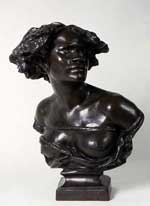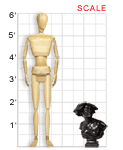VAM galleries including this work:
University of Kentucky Art Museum | Go Figure || VAM Home
Jean-Baptiste Carpeaux (French, 1827-1875)
LA NÉGRESSE, 1868 (recast 1979)
Bronze; 23-5/8" X 16" X 13-1/8"
Gift of Mr. and Mrs. John R. Gaines in honor of President Otis A. Singletary, 82.4
University of Kentucky Art Museum
During the 19th century, France produced more sculpture than any other country, then or at any previous time in history. The ambitious rebuilding of Paris commissioned by Napoleon III and overseen by Baron Haussmann translated into steady work for sculptors through the awarding of civic commissions for architectural decoration. And the newly wealthy middle classes fueled a growing market for reproductive copies and reductions of celebrated monuments.
The bust La Négresse owned by the University of Kentucky Art Museum is a 1979 recast of the original, which was created in 1868. La Négresse was a cast of Jean-Baptiste Carpeaux’s preparatory model for Quatre Parties du monde (“Four Corners of the World”), a sculpture commissioned by the city of Paris in 1867 (and finished in 1874) as the crowning element of the fountain on the Avenue de l’Observatoire. The monumental grouping, now in the Petit Palais, consists of four standing female figures symbolizing the four quarters of the globe: Europe, Asia, Africa, and America. The ropes binding La Négresse underscore her poignant expression and the inscription “Pourquoi naître esclave?” (“Why be born a slave?”). When exhibited in the Salon of 1869, Carpeaux’s bust found an enthusiastic audience. He subsequently reproduced it in bronze and plaster editions for sale to private patrons.
Carpeaux is known for his ability to capture great emotion in his works, and La Négresse is no exception. While the statue depicts the bust of a slave woman in tattered clothes, the subject nevertheless appears strong and proud. It seems fair to say that La Négresse expresses the triumph of the human spirit in the face of adversity.
About the Artist
The son of a poor stonemason, Jean-Baptiste Carpeaux was born in 1827 in Valenciennes, France. At the age of 11, he moved to Paris, where he studied at the Petite École and later under François Rude at the École des Beaux-Arts. After winning the Prix de Rome in 1854, Carpeaux moved to Italy, where he studied the works of Michelangelo and other great artists of the Renaissance. In 1860, he completed Ugolino, an avant-garde work that sealed his reputation as the leading sculptor of his day. After returning to Paris in 1862, Carpeaux became the preferred artist of Napoleon III and his court.
Although he also etched and painted, Carpeaux is best known for his sculptures. His realistic style was based on an acute sense of observation. He devoted himself to large-scale commissions for public spaces, including the Louvre, Luxembourg Gardens, and the Opéra, the site of his most acclaimed work, The Dance (1865). His active, supple sculpture conveys an engaging personality and emotional depth and is considered the forerunner for the dynamic work of Rodin. Carpeaux was awarded the Cross of the Legion of Honor just months before his death in 1875.
Classroom Ideas
Discussion: What does this bust tell you about its subject? How? Compare La Négresse with Albert P. Henry’s Bust of Abraham Lincoln in the Speed Art Museum gallery. Though these busts were completed only three years apart, they differ quite a bit. Which is more expressive? What might account for these differences? Do you prefer one work to the other? Why?
View and discuss The Four Corners of the World, the large public piece for which this bust was a partial model. How do the two works compare? What impressions do they give? What role does public sculpture play in a community? Compare this work to other public sculptures in the Kentucky Virtual Art Museum, such as Ed Hamilton’s Cinque (Speed Art Museum) and The Spirit of Freedom (Kentucky Historical Society) and Joel T. Hart’s Woman Triumphant (Kentucky Historical Society).
Activities: Draw a model for a bust of a classmate or friend, showing how the bust would look from different angles. Try drawing using your subject as a live model and from photographs.
Research and display images of public sculptures in your community, your state, and around the world.
In groups, plan and design a public sculpture with a message you think is important.
Links
You’ll find a biography of Carpeaux and images of other works at the Metropolitan Museum of Art.
[www.metmuseum.org/toah/hd/carp/hd_carp.htm]
See sketches for this bust, in the order they were drawn, at the SeeAnew pages by Robert Taylor of Teachers College, Columbia University.
[www.tc.columbia.edu/taylor/SeeAnew/CNegresC.stm]
More works by Carpeaux can be seen at the Art Renewal Center and at Boston College.
[www.artrenewal.org/asp/database/art.asp?aid=629]
[www.bc.edu/bc_org/avp/cas/fnart/art/carpeaux.html]
For a comprehensive guide to Baptiste resources on the web, see the Artcyclopedia.
[www.artcyclopedia.com/artists/carpeaux_jean-baptiste.html]

